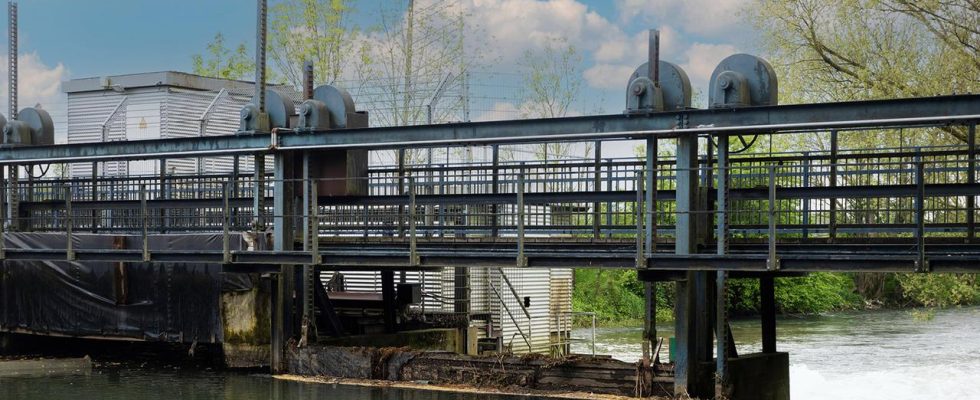Hydropower is mostly perceived as “green” energy. It constantly supplies climate-friendly electricity. Ecologists warn of the effects of the power plants on fish stocks.
Olaf Niepagenkemper likes to photograph nature. The biologist is also always on the move on the Lippe. But the pictures that he recently took on the small river north of the Ruhr area give him anything but pleasure. They show dead fish that have perished in front of a hydroelectric power station.
For the employee of the North Rhine-Westphalia Fisheries Association, one thing is clear: the problem is the many small hydroelectric power plants that exist along rivers such as the Lippe. Niepagenkemper and his association are calling for a ban on small hydropower plants below one megawatt out of concern for the fish stocks in the Lippe and many other German rivers.
Fish swim into the turbines
The damming of the water in front of the weirs creates large amounts of digested sludge. The produce large amounts of methane gas, 25 times more harmful to the climate than carbon dioxide, says Niepagenkemper. In addition, the water warms up in the storage area; this can then absorb less oxygen, and fish die off. Many fish would also be killed by following the current as they migrate and therefore swimming into the turbines.
The Federation of German Hydroelectric Power Plants (BDW) disagrees. Flowing water warmed up faster than standing water. The damming of the water in front of weirs would not result in any significant methane emissions. This is completely negligible, especially for the small hydropower plants, because floods that occur several times a year wash away the accumulated sludge again and again.
BDW board member Ronald Steinhoff admits that large systems often have ineffective or no fish protection. “However, I think it is inappropriate and unfair to mention this in connection with small systems. It should also be made clear that modern systems can no longer cause any relevant intervention in the fish population,” says Steinhoff.
Problem caused by small plants?
Association employee Niepagenkemper holds against it. His fishing association NRW has evidence that many attached rakes are too big to really protect the fish. There are no rakes at all on many large systems, and on some systems they are 40 or 60 millimeters apart – there is no protection for the fish at all.
He sees the problems primarily in the many small plants. They hardly produced any electricity, but caused a great deal of damage. “There are 7,600 plants in Germany. Of these, 7,200 are small hydropower plants that generate seven percent of the electricity, and the remaining 400 large plants produce 93 percent of the electricity,” calculates Niepagenkemper. So there is hardly any benefit for society.
Similar criticism comes from the German Environmental Aid. Small systems would be disproportionate to the benefit. “We have strongly advocated that small hydropower be removed from the subsidy in the Renewable Energy Sources Act and take a very critical view of the plants,” says Sabrina Schulz, Deputy Head of Nature Conservation and Biological Diversity.
Allegations are also directed against the authorities, who often do too little to ensure that requirements are met. For example, there is a regulation on how much water must remain in the river. “When the water is low, operators often feed more water into the turbine than is permitted. In times of frequent drought, this is particularly threatening for the creatures in the river,” says Schulz.
tedious approval processes
Exactly the opposite says BDW board member Steinhoff. He is convinced that hydroelectric power plants will become increasingly important as a result of climate change. Due to the increase in dry periods, it is becoming more important to be able to regulate runoff instead of simply letting water run off uselessly.
The Federal Association of Energy and Water Management emphasizes that there have been significant improvements in hydropower plants in recent years. Hundreds of millions have been invested, for example for voluntary measures to enable fish to migrate through the rivers. The problem, however, is that the planning and approval processes for this can often take up to ten years. This must be accelerated by politicians.
Investments in fish ladders
In fact, many operators of hydroelectric power plants and weirs have already done something to protect fish. For example, fish ladders were built to help the fish to migrate up the river past the installations. “But the best fish ladder cannot be as good as a running water system,” says biologist Niepagenkemper. “Sometimes the fish can’t find the stairs.”
As evidence, he cites an attempt in which the regional association of Westphalia and Lippe equipped the fish with small transmitters. A fish stood below a weir for 126 days – despite a very well connected fish ladder. The animal did not accept the path, but wanted to continue to follow the main stream. Only when there was a flood and the weir flaps were put in place did the fish continue on its way.
Niepagenkemper emphasizes that he and his association are not fundamentally opposed to hydropower. If many households were supplied with electricity by large systems over one megawatt, that could make sense and be in the interest of society. In the case of small systems, however, the ecological damage is much greater than the energetic benefit.

